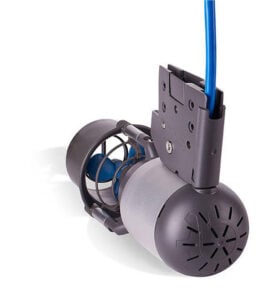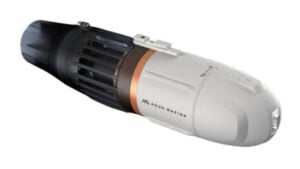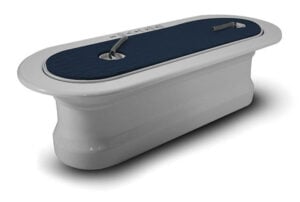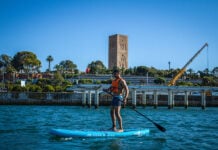Ten years ago, electric bikes were still considered quirky, and the people who pedalled them lesser cyclists—at least by their more purist peers. Today, electric-assist has become mainstream in every realm of cycling, from mountain biking to urban commuting and recreational riding.
Rapid technological advances, especially rechargeable batteries, mean e-bikes are no longer clunkier than conventional bicycles. They’re cool, functional, affordable—and here to stay. Today, e-bike sales are the fastest-growing sector in the bicycle industry. According to the National Bike Dealers Association, e-bikes are rapidly approaching 40 percent of all bicycles sold across U.S. and European markets.
Standup paddleboarding may be poised to follow suit. In just a few short years, a growing selection of compact, competitively priced and high-performing electric propulsion options have emerged. Just like e-bikes, proponents of e-SUPs say electric propulsion doesn’t diminish the standup paddling experience in the least. Instead, it can enhance it—increasing range, safety and accessibility.
Everything you wanted to know about electric SUPs
The cycling industry has watched electric-assist lure a broader and more diverse population into the saddle. Electric propulsion SUPs have the potential to do the same.
“People have different physical capabilities and paddling can be a different experience for a child, an adult or an elderly person,” says Sebastjan Sitar, founder of SipaBoards, an electric SUP manufacturer based in Slovenia.
“Whenever you’re surprised by a tide, current or wind, the motor is there to help you back,” Sitar continues. “It’s safer. And it’s more fun because you can go faster, farther and discover more.”

Today, there’s a variety of designs and propulsion options for e-SUPs. Many are available as aftermarket conversion kits that can be easily installed on your favorite board using a simple fin box attachment. Others are complete, fully integrated board, battery and electric motor packages. Here’s a closer look at what you’ll find if you explore electric.
The case for going electric
Standup paddleboarding is a silent, self-powered sport that provides a complete workout by strengthening your core and working on your balance. So, for some avid paddleboarders, electric propulsion sounds like cheating or simply unnecessary. But while it’s true that ever-improving battery life means you could zip around for hours without ever lifting your paddle, most e-SUP paddlers are seeking more of a hybrid experience.
For starters, consider range. With an electric SUP, you can go farther and get there faster, increasing options on where to paddle and how far you can explore. Compact electric propulsion systems allow you to paddle your board just as you usually would, then engage the electric motor to assist or take over if you become tired.
Electric propulsion can also enhance safety, making getting back to the launch easier if you get caught out by wind, changing tides or challenging currents. Even die-hard paddlers can appreciate the security of knowing they won’t be blown backward or offshore if they stop paddling.
“We came up with the idea after getting into standup paddleboarding and every time we would go out, we’d be fighting headwinds or strong currents,” confirms Mike Radenbaugh, cofounder of Seattle-based ElectraFin, one of the very first SUP electric conversion kits.
Paddlers can also use a low-speed electric motor to provide a little boost while paddling a fully loaded board. This is a great option for bringing kids, dogs or a friend with less effort. And just like their kayak counterparts, SUP anglers will quickly see the benefits of electric-assist for fishing.
Finally, electric SUPs can make paddleboarding more inclusive. “E-SUPs provide access for people with more limited mobility,” says Tom Watson, president of ePropulsion USA, “they allow people to get on the water easily, anywhere.”
With the global megatrend toward electric mobility, demand for e-SUPs is growing steadily, claims Sitar.

It’s electric: Current propulsion options
The first dedicated standup paddleboard electric conversion kits hit the water in 2013, with integrated jet drive electric paddleboards emerging just a couple of years later. Since then, advances in rechargeable batteries and electric motors have increased run time and range while decreasing size and weight.
Like e-bikes, electric SUPs transfer power from a battery to an electric motor. And similar to e-bike engineers, e-SUP designers have invented a few nifty ways to propel that motor. Today’s e-SUPs use three main electric propulsion options. Each system offers different benefits and trade-offs when it comes to features and performance.

1 Electric propeller drive
These systems use a submerged propeller with a built-in electric motor, usually installed in place of the center fin using a universal adapter. Installation is quick and easy, so you can share the drive between multiple boards. The chief advantage of these electric conversion kits is they can be mounted to just about any paddleboard, instantly converting your favorite board into an e-SUP.
Propeller drives are quiet, efficient and can provide good range and speed—up to 11 km/hr for some models. They’re also the most affordable electric conversion option, retailing for as little as $400 for a complete kit.
Some propeller systems replace the center fin, significantly reducing tracking when the motor is off. They also create more paddling resistance than other electric options—two important considerations if you mostly enjoy paddling your SUP and only plan to use the motor occasionally. The propeller is also more susceptible to damage or entanglement from underwater obstacles and seaweed. Another option is to mount the prop system on an adjustable adapter arm, raising and lowering as necessary.
You’ll need to store the battery pack somewhere on your board. Fortunately, e-SUP batteries are increasingly low profile, and most paddlers slip the waterproof case under the rear deck bungees. Expect the combined battery and motor weight to add up to 11 pounds to your board.
Electric propeller kit manufacturers include Bixpy, ePropulsion (makers of the Vaquita) and Aqua Marina.

| Photo: Courtesy Aqua Marina
2 Electric fin propulsion
These conversion kits are installed similarly to electric propeller drives, using a motorized fan mounted in the board’s fin system. However, instead of an external battery, electric fins use an all-in-one design with integrated batteries. The tube-shaped design allows for a versatile propulsion system that can be used on your SUP or handheld for underwater propulsion when snorkeling or diving.
Electric fins use either a compact turbine or a powerful water jet system to provide propulsion. The streamlined designs leave your board’s deck free of battery packs and cable connections. Turbine fins can provide up to a 7 km/hr boost, while jet fins are capable of speeds up to 11 km/hr.
The major drawback to an all-in-one electric fin is the smaller batteries provide limited range. Depending on the model, you can expect a maximum of 60 to 120 minutes of run time at easy cruising speed. These systems are also a more expensive option than conventional electric propeller conversion kits.
Current electric fin options include the Scubajet and Aqua Marina Bluedrive X.

3 Integrated electric jet propulsion
Fully integrated electric jet drive SUPs work similarly to jet skis, with a water intake and jet nozzle for propulsion driven by an electric motor. These systems are available as complete board packages with various inflatable, travel-friendly designs, including touring, all-round and angler models.
The slick, all-in-one design is what makes these self-inflating e-SUPs so appealing. A waterproof pod housing the jet propulsion motor, compact air compressor and rechargeable battery inserts seamlessly into the center of the paddleboard. The built-in paddleboard pump inflates the board in minutes with the push of a button, using its own power supply.
Jet propulsion systems are powerful and can boast impressive speeds—7–11 km/hr, depending on the board—with up to six hours of battery life. “People just go all-in on these boards,” confirms SipaBoards founder Sitar. “We have users reporting 30- to 40-kilometer rides on a single tour.”
They’re also reasonably lightweight, with the jet drive weighing about 11 pounds and an overall weight of around 30 pounds for a 12-foot-long board.
Another major advantage of these systems is their paddle-friendly functionality. Integrated jet propulsion offers true electric-assist, enhancing your paddle stroke just like pedal-assist on an e-bike. Since the drive doesn’t compromise the fin system, the SUP feels and tracks just like a regular paddleboard. And if you choose to paddle the board completely unassisted, the drive creates zero resistance.
There are a couple drawbacks to an integrated jet drive board. If you enjoy the tranquility of gliding along silently in nature, the noise of a jet propulsion drive can detract from the experience. At top speed, the motor produces around 64 decibels—about the same volume as a dishwasher or household vacuum. It’s what audio experts consider an intrusive level of sound.

Also, if you already have a SUP you enjoy paddling, an electric conversion kit offers a more affordable alternative to investing $2,000-$2,500 in a new inflatable electric board.
SipaBoards, Jobe and Torque offer top-quality inflatable boards with integrated electric jet propulsion.
Electric paddleboards: How they work & safety
Whichever propulsion system you choose, all e-SUPs include an easy-to-use remote for controlling the motor. The most common controller is a wireless remote that attaches to your paddle and allows you to adjust speed with the touch of a button. Some manufacturers also offer a wristwatch controller or an app for your smartphone.
The systems also have sensors and safeties to ensure the motor stops should you fall off the board or drop the control. Even so, you should always wear a leash when paddling an e-SUP. Wider, more stable boards or drop stitch inflatable SUPs are good choices for electric conversion kits, says ePropulsion’s Watson.
Keep in mind electric motors are designed to power through wind and mild chop while tracking straight. To steer and turn the board, you’ll still need to use your paddle. Using a nose rudder—steering with the blade placed beside the nose of the board—is the most effective way to maneuver your e-SUP. Moving your weight back on the board will also enable faster, tighter turns.
When it comes to safety, it’s important to remember electric SUP users must still develop and consider their paddling abilities. Yes, e-SUPs have the potential to increase speed and range, but you should only ever go as far as you’re able to physically paddle back.
Finally, nothing will harsh your mellow on a peaceful paddleboarding jaunt like range anxiety. Test your electric propulsion system in various conditions and speeds to accurately assess battery life. On a longer tour, save the electric-assist for the return journey. Electric propulsion only enhances safety if you conserve enough juice to get home.
Electric paddleboards can increase range, safety and accessibility—watt a time to be alive. | Feature photo: Andy Zeltkalns



 This article was first published in the Spring 2024 issue of Paddling Magazine.
This article was first published in the Spring 2024 issue of Paddling Magazine. 





An article about motor powered craft in a magazine devoted to paddling? Next article: Robot Mosquitos, Loons, and Moose – Your Guide to the Next Big Thing in Canoe Tripping